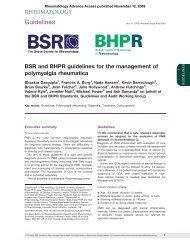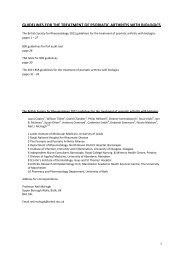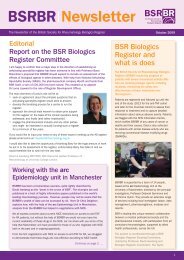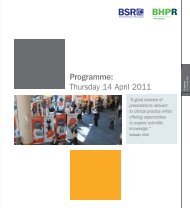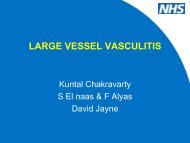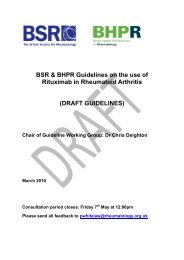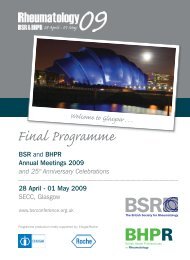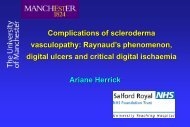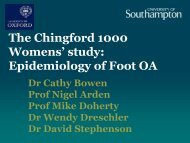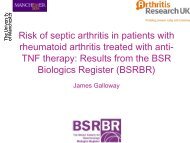Rheumatology Nursing: A Journey of Discovery - The British Society ...
Rheumatology Nursing: A Journey of Discovery - The British Society ...
Rheumatology Nursing: A Journey of Discovery - The British Society ...
Create successful ePaper yourself
Turn your PDF publications into a flip-book with our unique Google optimized e-Paper software.
<strong>Rheumatology</strong> <strong>Nursing</strong>:<br />
A <strong>Journey</strong> <strong>of</strong> <strong>Discovery</strong><br />
Jackie Hill<br />
Presenter Disclosure Information:<br />
Declaration <strong>of</strong> interest<br />
This speaker has no conflicts <strong>of</strong> interest
1970’s<br />
• In the 1970’s hospitals had rheumatology<br />
wards’ & rheumatologists<br />
• <strong>Rheumatology</strong> <strong>Nursing</strong> was not recognised<br />
as a specialty in the UK, classed with<br />
‘geriatric’ nursing
1980’s – <strong>The</strong> <strong>Journey</strong> Begins in the UK!
RCN <strong>Rheumatology</strong> <strong>Nursing</strong> Forum<br />
• Forum started in 1981<br />
• 1 st meeting in Manchester elected:<br />
Chair - Sally Chesson<br />
Secretary - Vickie Stephenson<br />
Treasurer - Joan Ball<br />
• Hold 2 x 1.5 day conferences each year<br />
• Set up course for rheumatology nurses<br />
• Newsletter
1985<br />
• Vickie Stephenson realised that rheumatology<br />
care was multidisciplinary<br />
• Went on to establish a multi-pr<strong>of</strong>essional<br />
organisation – BHPR and became its first<br />
President<br />
• <strong>The</strong>se two organisations heralded the<br />
emergence <strong>of</strong> rheumatology as a truly<br />
recognised MDT specialty
New Roles<br />
Bed bath<br />
anybody?<br />
• Interesting to note that the RCN RNF did<br />
not really accept the concept <strong>of</strong><br />
rheumatology nurse working from out<br />
patient departments<br />
• Real rheumatology nurses worked at the<br />
bed side!!!
1980’s - New Roles<br />
• Too many patients and not enough<br />
rheumatologists<br />
• In Leeds nurses employed to work in out<br />
patient departments to take clinical<br />
measurements in clinical drugs trials
<strong>The</strong> Leeds Experience<br />
• Began to take on responsibility for disease<br />
management and PE<br />
• Patients began to request nursing<br />
consultations - Our first nurse-led clinics<br />
• 1985 - ‘<strong>Nursing</strong> clinics for arthritis’<br />
• 1986 – ‘Patient evaluation <strong>of</strong> a rheumatology<br />
nursing clinic’
By the End <strong>of</strong> 1980’s<br />
• <strong>Rheumatology</strong> <strong>Nursing</strong> Clinics began to<br />
appear in the UK<br />
• ENB 983 Advanced Course in<br />
<strong>Rheumatology</strong> & Rehabilitation<br />
• One month certificated course
1989 Standards <strong>of</strong> Care – Rheumatic<br />
Disease <strong>Nursing</strong>, Scutari Press
1990’s – A Time <strong>of</strong> Consolidation<br />
• Many more NLC appeared, nurses began publishing<br />
papers describing the work they did<br />
• 1994 - Val Arthur<br />
<strong>Nursing</strong> care <strong>of</strong> people with rheumatoid arthritis. BJN<br />
• 1996 – Sarah Ryan<br />
Defining the role <strong>of</strong> the specialist nurse. Nurs Stand<br />
• 1999 – Anne Sutcliffe<br />
A regional nurse led osteoporosis clinic. Nurs Stand
An evaluation <strong>of</strong> the effectiveness, safety and<br />
acceptability <strong>of</strong> a nurse practitioner in a rheumatology<br />
outpatient clinic<br />
• 70 RA patients random allocation CR or NS<br />
(n=35)<br />
• Seen on 6 occasions over a 12 month period<br />
• Battery <strong>of</strong> outcome measures &<br />
questionnaires<br />
Hill J, Bird HA, Harmer R, Wright V, Lawton C (1994) Br J Rheumatol, 33:283-<br />
288.
Assessment CR Clinic CNS Clinic<br />
Biochemical PV ** **<br />
CRP = =<br />
Clinical Articular Index * ****<br />
Morning stiffness = *<br />
Pain = **<br />
Physical Function = =<br />
Psychological Anxiety = ***<br />
Depression = **<br />
Overall status = ***<br />
Knowledge Overall = ****<br />
Pat Satisfaction Overall = ****<br />
= no change *improvement significant 5% level, ** improvement significant 1% level<br />
***improvement significant 0.1% level<br />
****improvement significant 0.01% level
1990’s - Consolidation<br />
• Nurses taking on new responsibilities<br />
• Needed to access to new knowledge and skills<br />
• 1995 – IAI course began Cannock Chase<br />
Hospital<br />
• 1999 - Sarah Ryan and Andy Hassell produced<br />
the <strong>Rheumatology</strong> <strong>Nursing</strong> Masters course at<br />
Keele University
Computerisation<br />
Kind permission from ‘Little Dog Laughed’
Please!
2000 – New millennium, new leaps<br />
forward and few retrograde steps!
2000’s – Leaps Forward<br />
• 1997 AR UK set up AHP Working Party<br />
• Undertook workshops and national survey<br />
• 203 nurses responded<br />
• Published findings in 2001
Defining the Extended Clinical Role for<br />
Nurses in <strong>Rheumatology</strong> in the UK<br />
Functions<br />
% <strong>of</strong> Nurses who<br />
Routinely Perform<br />
these Functions<br />
Give information and advice to patients 82<br />
Read/record blood results 73<br />
Give information and advice to relatives 71<br />
Refer to other health pr<strong>of</strong>essionals 58<br />
Provide counselling to patients 54<br />
Run drug monitor clinics 53<br />
Order clinical investigations 52<br />
Carr et al 2001
2000’s<br />
• 20% <strong>of</strong> nurses had significantly extended roles<br />
• Joint injections<br />
• Reading x-rays<br />
• Running specialist clinics<br />
• Recommending treatment changes to<br />
rheumatologists and GPs<br />
• Research<br />
• Teaching
2001 2003 & 2009 2004<br />
Telephone<br />
Advice 2006
<strong>The</strong> Nurse Consultant Role –<br />
Another Leap Forward<br />
Brought about by:<br />
• Limitations in career structure<br />
• Experienced nurses leaving the pr<strong>of</strong>ession<br />
• Lack <strong>of</strong> expert clinical leadership
<strong>The</strong> <strong>Rheumatology</strong> Nurse Consultant<br />
• In 1999 aim was for 1000 Nurse Consultants by<br />
2004<br />
• In 2000 Sarah Ryan became the first RNC in the<br />
UK<br />
• >10 at the present time
What Does the Role Involve?<br />
Defined criteria for the role<br />
• 50% in direct clinical care<br />
• Education<br />
• Research<br />
• Leadership
An Evaluation <strong>of</strong> Nurse Consultant Roles<br />
• In depth interviews and questionnaire survey<br />
• 528 Nurse Consultants identified 419(79%) response<br />
• 53% worked in a clinically based specialty area (A&E<br />
or care <strong>of</strong> the elderly)<br />
• 23% mental health<br />
• 11% condition based specialty<br />
• 8% midwifery<br />
• 5% community/primary care<br />
Guest et al 2004. An evaluation <strong>of</strong> the impact <strong>of</strong> nurse, midwife and health visitor<br />
consultants. Kings College, London
An Evaluation <strong>of</strong> Nurse Consultant Roles<br />
• Broad target <strong>of</strong> spending 50% directly with patients<br />
• 43% were attaining this<br />
• 48% claimed a high impact on the standards <strong>of</strong> care<br />
patients’ received<br />
• 40% improved follow up care
2000 Retrograde Steps -<br />
Justifying the Role <strong>of</strong> the CNS<br />
• 2006 funding deficit within the NHS – Trusts were<br />
required by Government to balance their books!<br />
• Simultaneously, job evaluations and pay awards<br />
resulting from Agenda for Change were<br />
implemented<br />
• CNS posts identified as potential areas for cost<br />
saving<br />
• Reductions in wage bill and help with the black hole<br />
in pensions funds
2000 - Justifying the Role <strong>of</strong> the CNS<br />
• Posts were lost in rheumatology but not known<br />
how many<br />
• Lack <strong>of</strong> cost effectiveness evidence for the CNS<br />
role in rheumatology from the UK<br />
• Research had gained impetus during the 1990’s<br />
& this decade
A randomized comparison <strong>of</strong> care provided by a clinical nurse<br />
specialist, an in-patient team, and a day patient team in RA<br />
• RCT into 3 groups<br />
• 210 RA patients difficulty with function<br />
• Clinical assessments recorded 0, 6, 12, 26 and 52<br />
weeks<br />
• Satisfaction VAS at week 6 all patients and at week<br />
12 for CNS patients<br />
Tijhuis et al AC&R 2002;47:525-31
Outcome Measures<br />
• Health Assessment Questionnaire*<br />
• McMaster Toronto Arthritis Patient Preference Disability<br />
Questionnaire*<br />
Secondary measures<br />
• RAND 36<br />
• RAQoL<br />
• Health Utility Rating Scale<br />
• DAS<br />
• VAS<br />
(QoL)<br />
(QoL)<br />
(Health Utility)<br />
(Disease Activity)<br />
(Patient Satisfaction)<br />
*Primary Outcome Measures
Results From all 3 Studies<br />
• All 3 groups improved FS, QoL, Health Utility<br />
• Care from the CNS has similar clinical outcome in<br />
comparison with inpatient and day patient team care<br />
• <strong>The</strong> results <strong>of</strong> from the 52 week study remained<br />
stable until 104 weeks<br />
• Total cost per patient 2 years:<br />
CNS: €11,572 Day Care: €16,896 In pat: €22,449
Outcomes for Patients with RA: A <strong>Rheumatology</strong> Nurse<br />
Practitioner Clinic Compared to Standard Outpatient Care<br />
80 patients from Consultant clinic<br />
RNP clinic<br />
39 RA patients<br />
JHD clinic<br />
41 RA patients<br />
Weeks 0, 2, 12, 24, 36, 48<br />
Hill et al Musculoskeletal Care 2003;1:5-20
RA Cohort<br />
RNS (n=41)<br />
JHD (n=36)<br />
Fatigue p
Impact <strong>of</strong> a rheumatology expert nurse on the well<br />
being <strong>of</strong> patients attending a drug monitoring clinic<br />
• Single blind RCT<br />
• 71 RA patients<br />
• Starting a new DMARD<br />
• Randomised to a CNS (n=36) clinic or an<br />
outpatient nurse (n=35)<br />
• Visits at 0, 3, 7, 12 months<br />
Ryan et al J Adv Nurs 2006;53:277-86
End Point Results<br />
• RAI change score improved 1.8 in CNS group<br />
and deteriorated 0.3 in the CG (NS)<br />
• DAS scores improved significantly CNS but no<br />
change CG, difference significant (p
Do OA Patients Gain Additional Benefit from Care<br />
from a Clinical Nurse Specialist? – An RCT<br />
100 Patients from Consultant Clinic<br />
RNS clinic<br />
51 OA patients<br />
JHD clinic<br />
49 OA patients<br />
Weeks 0, 16, 32, 48<br />
Hill et al 2009 <strong>Rheumatology</strong>;48:664
Results - Osteoarthritis Study<br />
• Better outcomes for pain, morning stiffness,<br />
physical function and self-efficacy RNS group<br />
• Patient knowledge and satisfaction favoured<br />
the RNS (p>0.05)<br />
• Patients gained additional benefit as they were<br />
better informed about their disease and<br />
significantly more satisfied with their care
2010 and onwards……
<strong>The</strong> effectiveness <strong>of</strong> nurse-led care in people<br />
with RA : A systematic review<br />
Ndosi et al. Int J Nurs Stud 2011: 48:642-654<br />
• Only found 7 articles describing 4 RCTs<br />
• Meta analysis on 431 patients<br />
• Most effect sizes inconclusive<br />
• AI, QoL, Patient Knowledge (p
Who Responded?<br />
• 274 rheumatology nurses<br />
• 262 (96%) female<br />
• Average age was 48 yrs (26 – 71)<br />
• 113 (41%) were 50 yrs or older<br />
• Nurses qualified 24 yrs (2 – 48 yrs)
Number <strong>of</strong> nurses<br />
<strong>Nursing</strong> Qualifications<br />
140<br />
47%<br />
47%<br />
120<br />
100<br />
80<br />
60<br />
40<br />
20<br />
0<br />
36%<br />
33%<br />
26%<br />
22%<br />
Diploma Undergrad Masters PhD Teaching Prescribing<br />
Qualifications Obtained
% Nurses<br />
Hours Allocated for Telephone<br />
Helpline<br />
35<br />
30<br />
25<br />
20<br />
15<br />
10<br />
5<br />
0<br />
0.5 - 2 >2 - 4 >4 - 6 >6 - 37.5<br />
Hours per Week
Percent<br />
Non Clinical Activities<br />
70<br />
60<br />
50<br />
40<br />
30<br />
20<br />
10<br />
0<br />
Essential sp clinical<br />
admin<br />
Essential non-sp<br />
clinical admin<br />
Non-essential non<br />
clinical admin<br />
Team/PD
Pandora (s<strong>of</strong>tware workload modelling tool)– Susan<br />
Oliver & Alison Leary<br />
BJN: 2012:2(1):32-37
Pandora study<br />
• Nationwide study<br />
• 99 nurses who recorded their activities<br />
• 3324 intervention events representing 101<br />
nursing days<br />
• 2,227 clinical intervention
Top 5 Outcomes<br />
• 21% alleviation <strong>of</strong> suffering - Physical assessment and<br />
specialist symptom management<br />
• 19% assessing and meeting information needs<br />
• 14% rescue work particularly in drug therapy<br />
• 11% alleviation <strong>of</strong> psychological suffering<br />
• 11% access to key contact / knowledgeable<br />
pr<strong>of</strong>essional or brokering rapid access to other<br />
pr<strong>of</strong>essionals
AR UK Project Grant<br />
Started February 2008 last patient completed March 2011
Clinical outcomes<br />
• DAS28 – Primary outcome<br />
• Pain, fatigue and stiffness<br />
• Quality <strong>of</strong> life (RAQoL)<br />
• Functional ability (HAQ)<br />
• Self-efficacy (ASES)<br />
Economic Evaluation<br />
• EQ5D – Quality adjusted<br />
life Years (QALYs)<br />
• Cost - NHS costs,<br />
Healthcare costs, <strong>Society</strong><br />
costs<br />
• Psychological well-being<br />
(HADS)<br />
• Satisfaction with care (LSQ)
622 Invited<br />
371 - No response<br />
29 - Not eligible<br />
41 - Declined<br />
181 Randomly assigned<br />
91 randomised to NLC<br />
- 9 protocol deviations<br />
90 randomised to RLC<br />
-14 protocol deviations<br />
82 PP analysis<br />
91 ITT analysis<br />
76 PP analysis<br />
90 ITT analysis
Results<br />
• Mean change in average DAS 28 significantly<br />
greater NLC than the RLC group<br />
• NLC higher patient satisfaction<br />
• Lower health care costs<br />
• QALYs favoured RLC<br />
• Uncertainty over cost-effectiveness
Geriatric Nurses<br />
Became Organised RCN RF / BHPR<br />
Conferences Papers and Text Books<br />
Psychological Support<br />
Referrals<br />
Courses to MSc Level<br />
Teach Self Management<br />
Telephone Advice Lines<br />
Practice Development<br />
Physical Examination Order / Interpret Investigations<br />
Disease Management<br />
Nurse Consultants<br />
Admitting to Wards<br />
Clinical Nurse Specialists<br />
Intra Articular Injections<br />
Teaching Leadership Mentoring<br />
Prescribing High Quality Research<br />
Nurse - Led Services
What About the Future?<br />
• Going to be difficult times ahead, no idea<br />
how the new NHS will pan out<br />
• Could adversely effect rheumatology<br />
• Need to be vigilant<br />
• Number educational courses may decline<br />
• Change brings opportunities
What About the Future?<br />
• Need more research to produce the<br />
evidence for rheumatology nursing<br />
• Need to use mixed methodology<br />
• Statistical model such as the Structural<br />
Equation Model (SEM) could be <strong>of</strong> use
Direct effects on Quality <strong>of</strong> Life in OA<br />
Anxiety<br />
0.57<br />
Pain<br />
0.34<br />
Quality <strong>of</strong> Life<br />
0.81<br />
Function<br />
Number <strong>of</strong> comorbidities<br />
Duration <strong>of</strong><br />
disease<br />
0.22<br />
Kind permission Dr Anne-Maree Keenan<br />
Age
Physical and Psychosocial Effects on QoL in OA<br />
Keenan et al, 2008<br />
0.48<br />
Anxiety<br />
0.57<br />
Pain<br />
0.39<br />
0.45<br />
0.34<br />
Quality <strong>of</strong> Life<br />
0.81<br />
Function<br />
0.33<br />
Number <strong>of</strong> comorbidities<br />
0.17<br />
0.18<br />
Duration <strong>of</strong><br />
disease<br />
0.22<br />
0.22<br />
0.18<br />
0.15<br />
Age<br />
Kind permission Dr Anne-Maree Keenan
Making a Difference
• Dr Jill Firth<br />
• Consultant Nurse in<br />
<strong>Rheumatology</strong><br />
• Senior Research<br />
Fellow<br />
• Seminal research on<br />
foot ulceration – 1/10<br />
RA will acquire a foot<br />
ulcer
• Pr<strong>of</strong>essor Sarah Hewlett<br />
• 1 st Pr<strong>of</strong>essor<br />
<strong>Rheumatology</strong> & <strong>Nursing</strong><br />
• Consultant Nurse<br />
• Fatigue<br />
• Ensuring patients are<br />
involved in the research<br />
process<br />
• Helping patients cope with<br />
arthritis
• Pr<strong>of</strong>essor Candy McCabe<br />
• 2 nd <strong>Nursing</strong> Pr<strong>of</strong>essor<br />
• Consultant Nurse<br />
• Work on regional pain<br />
syndrome<br />
• Chronic Unexplained Pain
• Dr Mwidimi Ndosi<br />
• Researcher & practitioner<br />
in <strong>Rheumatology</strong><br />
• Outcomes from nurse led<br />
clinics<br />
• Economic evaluation<br />
• Educational Needs<br />
Assessment Tool
• Susan Oliver<br />
• Nurse Consultant<br />
• Past Chair <strong>of</strong> RCN RF<br />
• Leadership many <strong>of</strong> the<br />
guidelines produced<br />
• Prolific author<br />
• Very politically aware!
• Dr Sarah Ryan<br />
• 1 st Nurse Consultant<br />
• Editor Musculoskeletal<br />
Care<br />
• MSc course leader<br />
• Prolific author
“Change comes from small initiatives<br />
which work, initiatives which imitated,<br />
become the fashion. We cannot wait for<br />
great visions from great people, for they<br />
are in short supply at the end <strong>of</strong> history.<br />
It is up to us to light our own small fires in<br />
the darkness”<br />
Charles Handy (1994) Irish author and philosopher
Welcome to<br />
<strong>The</strong> 2012<br />
DROITWICH LECTURE
LIFETIME ACHIEVEMENT<br />
Dr Jackie Hill:<br />
For outstanding service<br />
to rheumatology and<br />
allied health<br />
pr<strong>of</strong>essional working<br />
AWARDED BY THE BHPR
Presentation on behalf <strong>of</strong><br />
EULAR <strong>Nursing</strong> Task Force
2012<br />
Prizes and Awards<br />
Recognising and celebrating<br />
achievements and innovations<br />
that change the face <strong>of</strong><br />
rheumatology
Chris Moran poster prize
<strong>The</strong> winner <strong>of</strong> the Chris Moran Poster Prize<br />
2012 is:
BHPR/Arthritis Research UK<br />
research silver medal
BHPR/Arthritis Research UK<br />
research UK silver medal<br />
research prize<br />
Miss Victoria Manning,<br />
King's College London, London<br />
Physical inactivity among UK adults with rheumatic<br />
diseases: an evaluation <strong>of</strong> physical activity<br />
participation, recommendation and preferences
Physical inactivity among UK<br />
adults with rheumatic diseases:<br />
an evaluation <strong>of</strong> physical activity<br />
participation, recommendation<br />
and preferences<br />
Victoria Manning
Physical Activity Audit<br />
UK physical activity guidelines (2011)<br />
2008, 2009 NICE guidelines<br />
508 patients with rheumatic conditions<br />
Inner city UK hospital<br />
2-page questionnaire (IPAQ)<br />
61% met the 2011 PA guidelines<br />
27% entirely inactive<br />
48% had never discussed physical activity<br />
with a healthcare pr<strong>of</strong>essional<br />
50% would welcome advice
Thank you!<br />
• All participants<br />
• Dr. Lindsay Bearne, King’s College London<br />
• Pr<strong>of</strong>. Mike Hurley, St. George’s University <strong>of</strong> London<br />
• Pr<strong>of</strong>. David Scott, King’s College London<br />
• <strong>Rheumatology</strong> Team, King’s College Hospital<br />
• Physiotherapy Research Foundation, Chartered<br />
<strong>Society</strong> <strong>of</strong> Physiotherapy
Arthritis Research UK Awards
Arthritis Research UK<br />
Physiotherapy Silver Medal Prize<br />
Dr Jonathan Hill,<br />
Keele University, Stoke on Trent<br />
Comparison <strong>of</strong> stratified primary<br />
care management for low back<br />
pain with current best practice<br />
(STarT Back): a randomised<br />
controlled trial
Arthritis Research UK Podiatry<br />
Silver Medal Prize<br />
Dr Michael Backhouse,<br />
Division <strong>of</strong> Musculoskeletal Disease,<br />
University <strong>of</strong> Leeds, Leeds<br />
Factors predicting the outcome <strong>of</strong><br />
foot and ankle surgery in patients<br />
with rheumatoid arthritis
Factors predicting the outcome <strong>of</strong><br />
foot and ankle surgery in patients<br />
with rheumatoid arthritis<br />
M.R. Backhouse<br />
Division <strong>of</strong> Rheumatic and Musculoskeletal Disease,<br />
University <strong>of</strong> Leeds,<br />
Leeds Institute <strong>of</strong> Molecular Medicine
Background<br />
Epidemiology<br />
<strong>of</strong> foot and<br />
ankle surgery<br />
in RA<br />
Generation <strong>of</strong> Candidate<br />
Factors<br />
Background<br />
Perception <strong>of</strong> outcome from<br />
patient perspective<br />
Rheumatoid arthritis has a pr<strong>of</strong>ound impact on foot and<br />
Validation <strong>of</strong> Activity Monitors<br />
ankle (Michelson et al 1994, Grondal et al 2008, Helliwell 2005, Williams 2007)<br />
Longitudinal<br />
evaluation <strong>of</strong><br />
candidate factors<br />
ability to predict<br />
surgical outcome<br />
Study Type:<br />
Registry data<br />
Leeds Institute <strong>of</strong> Molecular Medicine<br />
Foot and Ankle surgery accounts for 1/3 <strong>of</strong> lower limb<br />
surgery in RA (Weiss et al 2006)<br />
Modified Delphi Process<br />
Surgical outcomes vary considerably and are <strong>of</strong>ten<br />
Qualitative Interviews<br />
suboptimal (Hamalainen et al 1997)<br />
Validation Study<br />
Aim<br />
Prospective<br />
cohort study
Methods<br />
• Prospective<br />
cohort<br />
• Baseline<br />
assessment <strong>of</strong><br />
candidate factors<br />
Methods<br />
• 12 month follow<br />
up<br />
• Exploratory<br />
analysis <strong>of</strong><br />
candidate factors<br />
conducted using<br />
CART analysis<br />
Leeds Institute <strong>of</strong> Molecular Medicine
Results<br />
CART analysis produced decision trees for<br />
different aspects <strong>of</strong> outcome<br />
Although predictor variables varied, three<br />
key constructs emerged:<br />
– Patients with higher baseline pain showed<br />
more improvement than those with lower<br />
pain<br />
– Patients with the severest deformity failed<br />
to improve as much as patients with less<br />
extensive foot deformity<br />
– Patients with tighter disease control<br />
showed greater improvement than those<br />
with less well controlled disease<br />
Requires validating in external cohort<br />
Leeds Institute <strong>of</strong> Molecular Medicine
Acknowledgements<br />
Dr Anthony C. Redmond<br />
Dr Anne-Maree Keenan<br />
Dr Philip S. Helliwell<br />
Dr Elizabeth M.A. Hensor<br />
Dr A. Isdale<br />
Dr A. Gough<br />
A. Emmerson<br />
A. Gill<br />
C. Bennett<br />
B. Starss<br />
P. Briggs<br />
A. Budgen<br />
C. Chebil<br />
C. Mann<br />
Dr D. Walker<br />
P. Heslop<br />
J. Madden<br />
D. Lavallette<br />
Dr L. Hordon<br />
Dr M. Green<br />
N. Harris<br />
M. Peat<br />
J. Pickard<br />
R. Monkhouse<br />
T. Nazzar<br />
Dr Z. Karim<br />
Leeds Institute <strong>of</strong> Molecular Medicine
Arthritis Research UK<br />
Occupational <strong>The</strong>rapy Silver<br />
Medal Prize<br />
Ms Kate Hackett,<br />
Newcastle University, Newcastle<br />
Functional impairment and<br />
primary Sjogren’s syndrome: a<br />
case for occupational therapy?
Functional impairment and primary Sjögren’s<br />
syndrome: A case for occupational therapy?<br />
Kate Hackett<br />
• pSS second most common autoimmune<br />
rheumatic disease<br />
• Affects secretary glands e.g. eyes and<br />
mouth<br />
• Fatigue, autonomic dysfunction, pain,<br />
sleep disturbance, depression,<br />
cognitive impairment<br />
• Impact on self care, productivity and<br />
leisure<br />
-work, eating, sexual function,<br />
functional mobility, concentration,<br />
engaging in social activities<br />
• Associated costs e.g. reduction in<br />
employment<br />
Hackett et al. Occupational therapy: A potentially valuable intervention for people with primary<br />
Sjogren's syndrome, <strong>British</strong> Journal <strong>of</strong> Occupational <strong>The</strong>rapy (in press)
Study<br />
• Measured impact <strong>of</strong> pSS symptoms on functional ability<br />
(Improved HAQ) and relationships between functional ability,<br />
systemic disease activity and patient reported symptoms<br />
• Responses received from 69 well characterised patients<br />
• Data compared with 69 age and sex matched healthy controls<br />
• pSS patients had a reduced capacity in carrying out a wide<br />
range <strong>of</strong> everyday activities compared with controls<br />
• Reduced function correlated strongly with fatigue, depression,<br />
pain, disease activity and impaired HR-QoL<br />
Hackett KL et al Functional impairment in primary Sjogren's syndrome. Arthritis Care<br />
and Research (in press)
A Case for Occupational <strong>The</strong>rapy<br />
• Effective at improving function in other<br />
conditions e.g. RA (Steultjens et al 2004)<br />
• Addresses specific areas <strong>of</strong> functional<br />
impairment<br />
• Sleep, pain, fatigue, low mood, daily activity<br />
management<br />
• Many pSS patients do not have routine<br />
access to OT<br />
• OT could facilitate improvement in function,<br />
quality <strong>of</strong> life and costs associated with the<br />
disease
Arthritis Research UK <strong>Nursing</strong><br />
Silver Medal Prize<br />
Mrs Patricia Cornell, <strong>Rheumatology</strong> Dept,<br />
Poole Hospital NHS Foundation Trust, Poole<br />
Don’t forget to clean your teeth - does<br />
informing patients about the link between<br />
dental hygiene and Rheumatoid Arthritis<br />
encourage better dental care?
BHPR Prizes and Awards 2013<br />
BHPR/Arthritis Research UK silver medal<br />
research prize<br />
BHPR /ALGEOS clinical prize<br />
BHPR student prize
BHPR ANNUAL GENERAL MEETING<br />
1 May 2012 , 1pm
APOLOGIES<br />
Andrea Graham<br />
Michael Backhouse<br />
Vicky Cameron-Fiddes<br />
Kanta Kumar<br />
Elizabeth Ssendi<br />
Alison Blake<br />
Cathy Ball<br />
Carol McCrum
AGENDA ITEM 2<br />
AGM 2011 MINUTES<br />
• CORRECTIONS<br />
• APPROVAL<br />
• MATTERS ARISING
AGENDA ITEM 3<br />
PRESIDENT’S REPORT<br />
- Lindsey Hawley
BHPR Goals<br />
• To ensure that the key role <strong>of</strong> the MDT is<br />
understood and reflected in policy and<br />
service planning.<br />
• To provide members <strong>of</strong> the MDT with<br />
knowledge, skills and tools needed to deliver<br />
best practice and quality care.<br />
• That members <strong>of</strong> the MDT have a voice through<br />
an effective, sustainable<br />
organisation.
MEMBERSHIP<br />
700<br />
BHPR membership Trend Line<br />
Mar 2009 to date<br />
600<br />
500<br />
400<br />
300<br />
No <strong>of</strong> Mems<br />
200<br />
100<br />
0
Education Update<br />
• Plans underway to conduct BHPR courses<br />
jointly with BSR<br />
• Endorsements <strong>of</strong> external courses up and<br />
running<br />
• First training survey conducted<br />
• Education Bursaries awarded end <strong>of</strong> 2011:<br />
- Sharon Gieve (Royal National Hospital for Rheumatic Diseases)<br />
- Helen McKeenan (Belfast City Hospital)<br />
• Potential for e-learning opportunities
COMMUNICATIONS<br />
• Resources<br />
• Conference<br />
• Links to external organisations<br />
• Website: Events page, Notice Board/Your<br />
page<br />
• New communication areas: Social media<br />
channels
Special Interest Groups<br />
• Rheumatoid Arthritis (Janet Cushnaghan)<br />
• Osteoporosis (Rachel Lewis)<br />
• Connective Tissue Disease (Sue Brown)<br />
• And a new Musculoskeletal Physiotherapy group<br />
- <strong>Rheumatology</strong> Physiotherapy (Jenny Ratcliffe)
PRIZES<br />
BHPR<br />
• Chris Moran Poster Prizes<br />
BHPR/Arthritis Research UK<br />
• Arthritis Research UK Silver Medal Research Prize<br />
Victoria Manning<br />
• Arthritis Research UK Physiotherapy Silver Medal Prize<br />
Jonathan Hill<br />
• Arthritis Research UK/PRCA Podiatry Silver Medal Prize<br />
Michael Backhouse<br />
• Arthritis Research UK Occupational <strong>The</strong>rapy Silver Medal Prize<br />
Kate Hackett<br />
• Arthritis Research UK <strong>Nursing</strong> Silver Medal Prize<br />
Patricia Cornell<br />
All prize applications are online
DROITWICH LECTURE<br />
• 2013 Lecturer - Dr Philip Helliwell<br />
- nominations will open in the autumn for the 2014<br />
lecturer
AGENDA ITEM 4<br />
TREASURER’S REPORT<br />
-Trish Cornell
• Annual Report and Accounts 2011<br />
circulated with AGM papers<br />
• Appointment <strong>of</strong> independent examiners<br />
– <strong>The</strong> trustees have decided to re-appoint Paul<br />
Furrer & Co as the independent examiner <strong>of</strong><br />
accounts
Treasurers report - 2012<br />
THE FUNDS OF THE CHARITY<br />
Endowment funds: 2011 2010<br />
Droitwich Medical Trust<br />
Lecture permanent endowment fund 60,000 60,000<br />
Restricted income funds:<br />
Special Interest Groups fund - 77<br />
Droitwich Medical Trust Lecture income fund 11,300 12,504<br />
Unrestricted income funds:<br />
General fund 25,827 30,773<br />
TOTAL CHARITY FUNDS £97,127 £103,354
2013 subs<br />
Direct Debit<br />
Cheque<br />
Ordinary members £30 £35<br />
Associate Overseas members £35<br />
Associate UK<br />
and Student members £21 £26
BHPR admin support<br />
• 2006<br />
– Commenced paying for admin support .5 day per week<br />
£5,000 +VAT PA<br />
• 2007<br />
– Council agreed an increase to 1 day per week £10,000 +<br />
VAT PA<br />
• 2008 Recession<br />
– Reduced interest rate<br />
– Loss <strong>of</strong> members<br />
• 2010 BHPR 25 th anniversary<br />
– Pharma support for dinner
AGENDA ITEM 5<br />
CLOSER WORKING<br />
ARRANGEMENTS<br />
WITH BSR
<strong>The</strong> Story So Far<br />
2003 BSR & BHPR: A Plan for Closer Collaboration<br />
• Increased cross representation<br />
• Joint conference planning<br />
• Joint education courses<br />
• Joint guidelines<br />
2011-2012: Review <strong>of</strong> Original Plan<br />
• Regular meetings <strong>of</strong> CEOs and Presidents <strong>of</strong> BSR & BHPR<br />
• Initial thoughts to membership at both AGMs 2011<br />
• Working group established<br />
– Meetings with ARHP (Association <strong>of</strong> <strong>Rheumatology</strong> Health<br />
Pr<strong>of</strong>essionals) to discuss the structure within ACR<br />
– Outline proposals drafted<br />
– Discussed at BHPR Council and BSR Executive and Council<br />
– Proposals approved in principle
<strong>The</strong> Bottom Line<br />
BHPR is not financially sustainable<br />
– BHPR needs reserves <strong>of</strong> 9 months running<br />
costs (£17,400)<br />
– Reserves January 2012: £25,827<br />
– Budgeted reserves December 2012: £17,957<br />
– Estimated reserves December 2013: £10,087<br />
– Estimated reserves December 2014: £2217
AHPR/ACR model<br />
• ARHP is a division <strong>of</strong> ACR<br />
– has its own executive and standing committees<br />
– budget, staff, and tax status are all part <strong>of</strong> the ACR<br />
• ARHP sets its own policies, projects and budget<br />
– consistent with the policies and procedures <strong>of</strong> the ACR<br />
– approved by the ACR Board <strong>of</strong> Directors<br />
– the approved budget and projects are managed by ARHP (under<br />
the ACR Board <strong>of</strong> Directors supervision).<br />
• ARHP president serves as a voting representative on the<br />
ACR Board <strong>of</strong> Directors<br />
– ARHP president-elect attends as an invited guest<br />
• One or more ARHP members serve on all ACR committees.
GOVERNANCE<br />
• Constitutional changes required<br />
• All changes need to comply with legal<br />
requirements<br />
– Charity Commission<br />
– BWB charity lawyers<br />
• A formal resolution will be put to the<br />
membership (BSR and BHPR) once legal<br />
advice has been sought
Outline Proposal To Be Agreed<br />
• That work continues to establish an integrated<br />
organisation whereby BHPR retains its discrete<br />
identity as a division <strong>of</strong> BSR.<br />
• This will include the following :<br />
– BHPR retains its own council and president<br />
– BHPR president to be a voting member <strong>of</strong> BSR<br />
Executive Committee<br />
– Increased AHP representation on BSR committees<br />
– Strengthening <strong>of</strong> financial relationship<br />
– AHP category <strong>of</strong> membership within BSR
Item 6<br />
ELECTIONS RESULT AND<br />
COUNCIL UPDATE
ELECTIONS<br />
• Ms Mel Holden has been elected<br />
unopposed as Honorary Treasurer<br />
• <strong>The</strong> Trustees have agreed to co-opt<br />
Lindsey Hooper for one year to AGM<br />
2013 as Deputy Communications <strong>of</strong>ficer
Thank you and Goodbye to the following<br />
representatives to BHPR Council:<br />
Victoria Chamberlain – RCN RF<br />
Richard Rees - BSR
Thank you and<br />
goodbye to:<br />
Andrea Graham<br />
Honorary Secretary
Thank you and<br />
Goodbye to:<br />
Trish Cornell<br />
Honorary Treasurer
Welcome to:<br />
Robert Field<br />
President<br />
2012 - 2014
And Thank you<br />
to:<br />
Lindsey Hawley<br />
President<br />
2010 – 2012
COUNCIL UPDATE<br />
Trustees are:<br />
• Robert Field<br />
President<br />
• Jill Firth<br />
Honorary Secretary<br />
• Mel Holden<br />
Honorary Treasurer<br />
• Lindsay Bearne<br />
Research Officer<br />
• Sue Gurden<br />
Communications Officer<br />
• Michael Backhouse<br />
Education Officer<br />
• Lindsey Hawley<br />
Past President<br />
Links & Representatives are:<br />
• Colin Beevor & Jo White – RCN<br />
• Cathy Ball – COTSSR<br />
• Jenny Ratcliffe – CSP<br />
Co-opted members to 2013:<br />
Jo Adams<br />
Research and Education Officer<br />
Lindsey Hooper<br />
Deputy Communications Officer
ANY OTHER BUSINESS<br />
-None received<br />
AND FINALLY…
Thanks to all the staff <strong>of</strong> BSR<br />
• With special<br />
thanks to BHPR’s<br />
Chief Executive<br />
and BSR’s<br />
Director <strong>of</strong><br />
Operations and<br />
Resources, Sue<br />
Murray-Johnson<br />
who has now left<br />
the organisation.
..and to all<br />
<strong>of</strong> you!
Prize draw<br />
See you all<br />
there!
Networking session<br />
<strong>Rheumatology</strong> Physio (SIG) RA (SIG) Connective Tissue Disease (SIG) Osteoporosis (SIG)<br />
BHPR General & communication Podiatry Occupational <strong>The</strong>rapy





